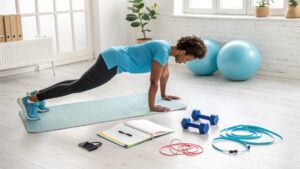Introduction
New to Fitness- Feeling overwhelmed by the sheer volume of fitness information online? You’re not alone. Stepping into a gym or even starting a home workout routine can be intimidating, leaving you wondering, “New to Fitness? Where Do You Even Begin?” This confusion is the number one barrier for most beginners. This guide is designed to cut through the noise. We’ll provide a clear, step-by-step roadmap grounded in science and expert advice, not fads. Forget the intimidation; it’s time to embark on your journey with confidence and build a sustainable, healthy lifestyle you love.
Laying the Foundation:

Before you even think about picking up a weight or lacing up your running shoes, the most critical work happens between your ears. Your mindset is the bedrock of your entire fitness journey. Approaching this new chapter with a positive, patient, and process-oriented attitude is what separates fleeting attempts from lifelong transformations. Ditch the “all or nothing” mentality. Fitness isn’t about punishing yourself for a donut; it’s about building a stronger, more capable version of yourself, one day at a time.
This is where effective goal setting comes in. Instead of vague aspirations like “get fit” or “lose weight,” employ the SMART framework: Specific, Measurable, Achievable, Relevant, and Time-bound. For example, a vague goal is “I want to run.” A SMART goal is “I will run for 20 minutes without stopping within the next 8 weeks.” This clarity provides a tangible target and makes your progress measurable. Furthermore, focus on process goals (e.g., “I will work out three times this week”) rather than solely outcome goals (e.g., “I will lose 10 pounds”). You can always control your actions, but outcomes are influenced by many factors. Celebrating small wins, like consistently completing your workouts, builds momentum and reinforces the habit, making the larger outcomes inevitable.
Understanding the Pillars of Fitness
Many beginners mistakenly believe fitness is just about cardio or just about lifting weights. In reality, a well-rounded program rests on four key pillars. Understanding these will help you create a balanced and effective routine that builds a resilient and capable body.
1. Cardiovascular Exercise
Cardio, or aerobic exercise, is any activity that raises your heart rate and improves your body’s ability to use oxygen. It’s famous for boosting heart health, burning calories, and improving endurance. For beginners, the best approach is low-impact, steady-state cardio. Think brisk walking, cycling on a stationary bike, swimming, or using an elliptical machine. The CDC recommends at least 150 minutes of moderate-intensity cardio per week. You can break this into manageable chunks, like 30 minutes, five days a week. The “talk test” is a great way to gauge intensity; you should be able to hold a conversation but not sing.
2. Strength Training
This is non-negotiable. Strength training builds lean muscle mass, which supercharges your metabolism (burning more calories at rest), strengthens bones and joints, and dramatically improves functional strength for daily life. A common myth frightens beginners: “lifting weights will make me bulky.” This is physiologically very difficult due to hormonal differences, especially for women. Instead, it creates a toned, strong physique. Begin with bodyweight exercises like squats, push-ups (on your knees if needed), and lunges. Gradually incorporate resistance bands, dumbbells, or machines, focusing on compound movements that work multiple muscle groups at once.
Designing Your

Now for the practical part: what does an actual workout look like? As a beginner, your mantra should be “start low and go slow.” Jumping into an advanced program is a fast track to injury, burnout, and quitting. A sample week for a total beginner might look like this:
-
- Day 1: Full-Body Strength Training (30 mins) + 10 mins of walking
-
- Day 2: 25-30 minutes of Moderate Cardio (brisk walk or bike)
-
- Day 3: Rest or Active Recovery (gentle stretching, yoga)
-
- Day 4: Full-Body Strength Training (30 mins) + 10 mins of walking
-
- Day 5: 25-30 minutes of Moderate Cardio
-
- Day 6: Rest or Active Recovery
-
- Day 7: Rest
Each strength session should include 1-2 exercises per major muscle group. For example:
-
- Legs: Bodyweight Squats (2 sets of 10-12 reps)
-
- Push: Knee Push-ups or Dumbbell Chest Press (2 sets of 8-10 reps)
-
- Pull: Banded Rows or Dumbbell Rows (2 sets of 8-10 reps)
-
- Core: Planks (2 holds for 20-30 seconds) and Bird-Dogs (2 sets of 10 per side)
The focus is not on lifting heavy but on mastering the movement patterns. Proper form is everything. Consider booking a single session with a certified personal trainer to learn these movements correctly—it’s an invaluable investment in your safety and long-term success.
The Role of Nutrition and Recovery
You cannot out-train a bad diet. Nutrition is the fuel that powers your workouts and the building blocks that repair your muscles afterward. Think of it as 80% nutrition, 20% exercise. However, this doesn’t mean a drastic diet. Start with simple, sustainable habits: prioritize protein intake (chicken, fish, eggs, Greek yogurt, lentils) to support muscle repair, eat plenty of fibrous vegetables, choose complex carbs (oats, sweet potato, brown rice) for energy, and stay hydrated. Drink water throughout the day, not just during your workout. Avoid the trap of “rewarding” your workout with a 500-calorie smoothie; it can easily negate the calories you just burned.
Equally important is recovery. Exercise creates microscopic tears in your muscle fibers; it’s during rest that they repair and grow stronger. Without adequate recovery, you risk overtraining, injury, and plateauing. Aim for 7-9 hours of quality sleep per night—this is when your body produces growth hormone for repair. Listen to your body: if you feel overly fatigued or sore, an extra rest day is more productive than a half-hearted, risky workout. Active recovery, like foam rolling or a gentle walk, can also aid circulation and reduce muscle soreness.
Staying Motivated and Tracking Progress
Initial motivation is easy; long-term consistency is the real challenge. Your motivation will wax and wane, which is why building discipline and habit is key. Schedule your workouts like any other important appointment. Find an accountability partner—a friend who also wants to start their fitness journey—to make it social and keep you committed. Furthermore, diversify your activities to avoid boredom; if you hate running, try dance classes, hiking, or rock climbing. Fitness should be enjoyable, not a chore.
Tracking your progress is crucial for maintaining motivation because the scale often doesn’t tell the whole story. Take “before” photos and measurements (chest, waist, hips, arms). These will show changes that the scale might not as you lose fat and gain muscle. Keep a simple workout log noting the exercises, weights, and reps you perform. The joy of adding five more pounds to your lift or running for one more minute is incredibly empowering. Celebrate these non-scale victories—they are the true markers of progress.
Conclusion: Your Journey Starts Now
Embarking on a new fitness journey is one of the most empowering decisions you can make. Remember, every expert was once a beginner. The path isn’t about perfection; it’s about consistency, patience, and showing up for yourself. You now have a foundational blueprint answering the question, “New to Fitness? Where Do You Even Begin?”—start with your mindset, understand the pillars, create a simple plan, fuel and recover well, and track your amazing progress.
Stop waiting for the “right time.” The right time is now. Your first workout can be a 15-minute walk today. What small step will you take? Share your first goal or a question you still have in the comments below—let’s support each other! For more guidance, check out our next article: “5 Beginner-Friendly Strength Exercises You Can Do At Home“.



